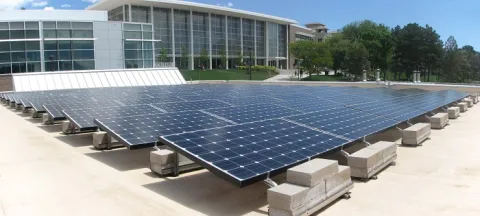
Renewable Energy
Solar Energy
Solar radiation, which is nearly constant outside the Earth's atmosphere, varies with changing atmospheric conditions (clouds and dust) and the changing position of the Earth relative to the sun. Nevertheless, almost all U.S. regions have useful solar resources that can be accessed.
There are two types of solar energy systems:
1. Solar thermal devices use direct heat from the sun, concentrating it in some manner to heat water to useful temperature. Currently, solar thermal devices do everything from heating swimming pools to creating steam for electricity generation.
2. Photovoltaic (PV) devices use semiconducting materials to convert sunlight directly into electricity. PV systems power small devices, homes, businesses, and college campuses. (Source: US Energy Information Administration).
UCCS utilizes both solar thermal and photovoltaic devices to supply energy for the campus. The solar thermal system on the roof of the Recreation Center provides 2/3 of the overall energy required to heat the swimming pool and spa. On sunny days it provides 100% of the energy so that no natural gas is required. On the roof of the Science & Engineering building, there is a solar thin film photovoltaic system that provides a small portion of the electricity needs.

Wind Energy
Winds are created by uneven heating of the atmosphere by the sun, irregularities of the Earth’s surface and the rotations of the Earth. The wind flow, or motion of energy when harvested by wind turbines, can be used to generate electricity. (Source: US Energy Information Administration)Wind has tremendous potential to produce energy. It is estimated that the top four states for wind (North Dakota, Texas, Kansas, and South Dakota) could supply all of our nation’s electricity needs. Colorado is the 11th windiest state in the country. In 2004, Colorado voters passed Amendment 37, which requires that utilities provide 10% of electricity from renewable sources by 2015. (Source: American Wind Energy Association, Colorado State Government)In 2010 Gov. Hickenlooper signed HB10-1001 which made it so that investor-owned utilities must have 30% of their electricity come from renewable energy by 2020. (Source:colorado.gov) Our local utility, Colorado Springs Utilities (CSU), is required to meet the renewable energy goals of Amendment 37. Currently, CSU purchases one megawatt of wind energy from the Ponnequin Wind facility, located across the Colorado-Wyoming border. CSU has issued RFP’s to purchase up to 100 megawatts of wind power with contracts to be awarded in 2009 and delivery in 2011. (Source: Colorado Springs Utilities)
Hydroelectric Energy
Water is currently the leading renewable energy source used by electric utilities to generate electric power. Hydroelectric plants operate where suitable waterways are available; many of the best of these sites have already been developed. Generating electricity using water has several advantages. The major advantage is that water is a source of cheap power. In addition, because there is no fuel combustion, there is little air pollution in comparison with fossil fuel plants and limited thermal pollution compared with nuclear plants. Like other energy sources, the use of water for generation has limitations including environmental impacts caused by damming river and streams, which affects the habitats of the local plant, fish and animal life. In 2004, Colorado voters passed Amendment 37, which requires that utilities provide 10% of electricity from renewable sources by 2015. Our local utility, Colorado Springs Utilities (CSU), is required to meet the renewable energy goals of Amendment 37. Currently, about 8% of the power produced by CSU is generated from hydroelectric sources. This power is produced at three local plants with a capacity of 33 megawatts: Manitou, Ruxton, and Tesla. A fourth plant, Cascade, is under construction and will provide 85 megawatts of electricity. CSU also purchases hydropower from the Western Area Power Administration. (Source: Colorado Springs Utilities.)
Geothermal Energy
Geothermal energy is heat from within the Earth. The steam and hot water produced inside the Earth can be used to heat buildings or generate electricity. Geothermal energy is a renewable energy source because the water is replenished by rainfall and the heat is continuously produced inside the Earth. Some applications of geothermal energy use the Earth’s temperatures near the surface, while others require drilling miles into the Earth. The three main uses of geothermal energy are:
1) Direct Use and District Heating Systems which use the hot water from springs or reservoirs near the surface.
2) Electricity generation in a power plant requires water or steam at very high temperature (300 to 700 degrees Fahrenheit). Geothermal power plants are generally built where geothermal reservoirs are located within a mile or two of the surface.
3) Geothermal heat pumps use stable ground or water temperatures near the Earth’s surface to control building temperatures above ground. (Source: US Energy Information Administration)
Biomass Energy
Biomass energy is derived from three distinct energy sources: wood, waste, and alcohol fuels.
1) Wood energy is derived both from direct use of harvested wood as a fuel and from wood waste streams. The largest source of energy from wood is pulping liquor or “black liquor,” a waste product from processes of the pulp, paper and paperboard industry.
2) Waste energy is the second largest source of biomass energy. The main contributors of waste energy are municipal solid waste (MSW), manufacturing waste, and landfill gas.
3) Biomass alcohol fuel, or ethanol, is derived almost exclusively from corn. It is used primarily as an oxygenate in gasoline. (Source: US Energy Information Administration) In Colorado, where much of the biomass comes from our forests or livestock, producing energy from biomass has other advantages with respect to sustainability: reduced waste, reduced use of landfills, reduced risk of wildfire, improved water-shed quality, as well as other economic benefits such as job creation in rural areas. (Source: Colorado Governor’s Energy Office)